Book of Hours, Use of Rouen, manuscript on vellum, in Latin and French, 98 leaves including initial and final blanks: fols. 1, 22v, 59v, 98v also blank, Modern foliation in pencil on the upper right corner (not taking into consideration first blank leaf), single column, 20 lines, ruled in brown ink, written in brown ink in a regular textura, major feasts in Calendar in gold, others alternating blue and mauve, 14 lines of prayers on fol. 98r in a different and slightly later hand,14 fine full-page miniatures, mostly in arched compartments, with full floriate and foliate borders, inhabited by birds, squirrels, monkeys and fantastic animals or occasionally flanked by multi-coloured marbled columns, smaller illuminated miniatures in Calendar, each page of text with illuminated floriate and foliate border on one side, in gold and colours, including some animals, numerous decorated illuminated initials in varying sizes, line-fillers throughout, a few small spots and stains but generally in bright and fresh condition, 20th century dark brown morocco by Baum, spine gilt, gilt-stamped morocco pastedowns, earlier gilt edges, 8vo (165 x 108mm.), Rouen, [1480s]. ⁂ An excellent example of an illuminated book of hours, the intimate prayerbook for the laity, produced in Rouen in the last quarter of the 15th century (possibly c.1480-1485): a mixture of devotion, literacy and luxury executed for a patroness. The style of the illumination and iconographical features allow us confidently to attribute its production to the workshop, or a close follower of the Maître de l'Échevinage, so named after a group of manuscripts he illuminated for the library of the Council of Aldermen (échevins) of Rouen, and now in the Bibliothèque Nationale in Paris. This highly esteemed and influential artist worked in the Norman town from 1450 to c.1485, and is also known as the Master of Latini Geneva, from a Brunetto Latini manuscript in the Geneva Library. The manuscript opens with the Calendar, in which the names of local saints are included - among others, Ansbertus (9th February), the patron of Rouen Romanus (23rd October), and Martialis (3rd July) - and further confirm its place of production. Each month is framed within an illuminated border containing vignettes representing the relevant sign of the zodiac and seasonal labours respectively. Landscapes and details are rendered with great care. Moreover, the manuscript contains 14 full-page miniatures, each introducing the traditional sections of the Book of Hours. The elaborate carved architectural structures or thrones, the draperies shaded in gold, and the landscapes visible beyond, with views of a walled town (possibly Rouen), are remarkable. The miniature opening the Gospel sequences (fol. 14r), which depicts all four evangelists, is particularly noteworthy. It departs from the standard iconography: while the four evangelists are normally all the same size, here the emphasis is placed on St. John, seated on Patmos island and in the act of writing on a scroll. Luke, Matthew, and Mark on the other hand are depicted in smaller marginal vignettes, and are represented in different activities: Luke writes, Matthew reads, and Mark examines the point of his pen. This unusual iconography is distinctive of the Échevinage Master, and is repeated - in slightly variant forms - by his followers. Other stylistic or iconographical characteristics are recognisable in the eight miniatures illustrating the Hours of the Virgin, and or in the macabre image of the Three Living and Three Dead introducing the Office of the Dead (fol. 72r), a set of prayers for the dead and dying. More specifically, the manuscript shows striking similarities with the MSS Walters 224 and 241 of the Walters Art Gallery in Baltimore, both produced in the 1480s by a follower of the Échevinage Master. Occasionally customers paid for having special miniatures in their Book of Hours, usually one representing themselves kneeling before the Virgin or a par
Book of Hours, Use of Rouen, manuscript on vellum, in Latin and French, 98 leaves including initial and final blanks: fols. 1, 22v, 59v, 98v also blank, Modern foliation in pencil on the upper right corner (not taking into consideration first blank leaf), single column, 20 lines, ruled in brown ink, written in brown ink in a regular textura, major feasts in Calendar in gold, others alternating blue and mauve, 14 lines of prayers on fol. 98r in a different and slightly later hand,14 fine full-page miniatures, mostly in arched compartments, with full floriate and foliate borders, inhabited by birds, squirrels, monkeys and fantastic animals or occasionally flanked by multi-coloured marbled columns, smaller illuminated miniatures in Calendar, each page of text with illuminated floriate and foliate border on one side, in gold and colours, including some animals, numerous decorated illuminated initials in varying sizes, line-fillers throughout, a few small spots and stains but generally in bright and fresh condition, 20th century dark brown morocco by Baum, spine gilt, gilt-stamped morocco pastedowns, earlier gilt edges, 8vo (165 x 108mm.), Rouen, [1480s]. ⁂ An excellent example of an illuminated book of hours, the intimate prayerbook for the laity, produced in Rouen in the last quarter of the 15th century (possibly c.1480-1485): a mixture of devotion, literacy and luxury executed for a patroness. The style of the illumination and iconographical features allow us confidently to attribute its production to the workshop, or a close follower of the Maître de l'Échevinage, so named after a group of manuscripts he illuminated for the library of the Council of Aldermen (échevins) of Rouen, and now in the Bibliothèque Nationale in Paris. This highly esteemed and influential artist worked in the Norman town from 1450 to c.1485, and is also known as the Master of Latini Geneva, from a Brunetto Latini manuscript in the Geneva Library. The manuscript opens with the Calendar, in which the names of local saints are included - among others, Ansbertus (9th February), the patron of Rouen Romanus (23rd October), and Martialis (3rd July) - and further confirm its place of production. Each month is framed within an illuminated border containing vignettes representing the relevant sign of the zodiac and seasonal labours respectively. Landscapes and details are rendered with great care. Moreover, the manuscript contains 14 full-page miniatures, each introducing the traditional sections of the Book of Hours. The elaborate carved architectural structures or thrones, the draperies shaded in gold, and the landscapes visible beyond, with views of a walled town (possibly Rouen), are remarkable. The miniature opening the Gospel sequences (fol. 14r), which depicts all four evangelists, is particularly noteworthy. It departs from the standard iconography: while the four evangelists are normally all the same size, here the emphasis is placed on St. John, seated on Patmos island and in the act of writing on a scroll. Luke, Matthew, and Mark on the other hand are depicted in smaller marginal vignettes, and are represented in different activities: Luke writes, Matthew reads, and Mark examines the point of his pen. This unusual iconography is distinctive of the Échevinage Master, and is repeated - in slightly variant forms - by his followers. Other stylistic or iconographical characteristics are recognisable in the eight miniatures illustrating the Hours of the Virgin, and or in the macabre image of the Three Living and Three Dead introducing the Office of the Dead (fol. 72r), a set of prayers for the dead and dying. More specifically, the manuscript shows striking similarities with the MSS Walters 224 and 241 of the Walters Art Gallery in Baltimore, both produced in the 1480s by a follower of the Échevinage Master. Occasionally customers paid for having special miniatures in their Book of Hours, usually one representing themselves kneeling before the Virgin or a par
.jpg)
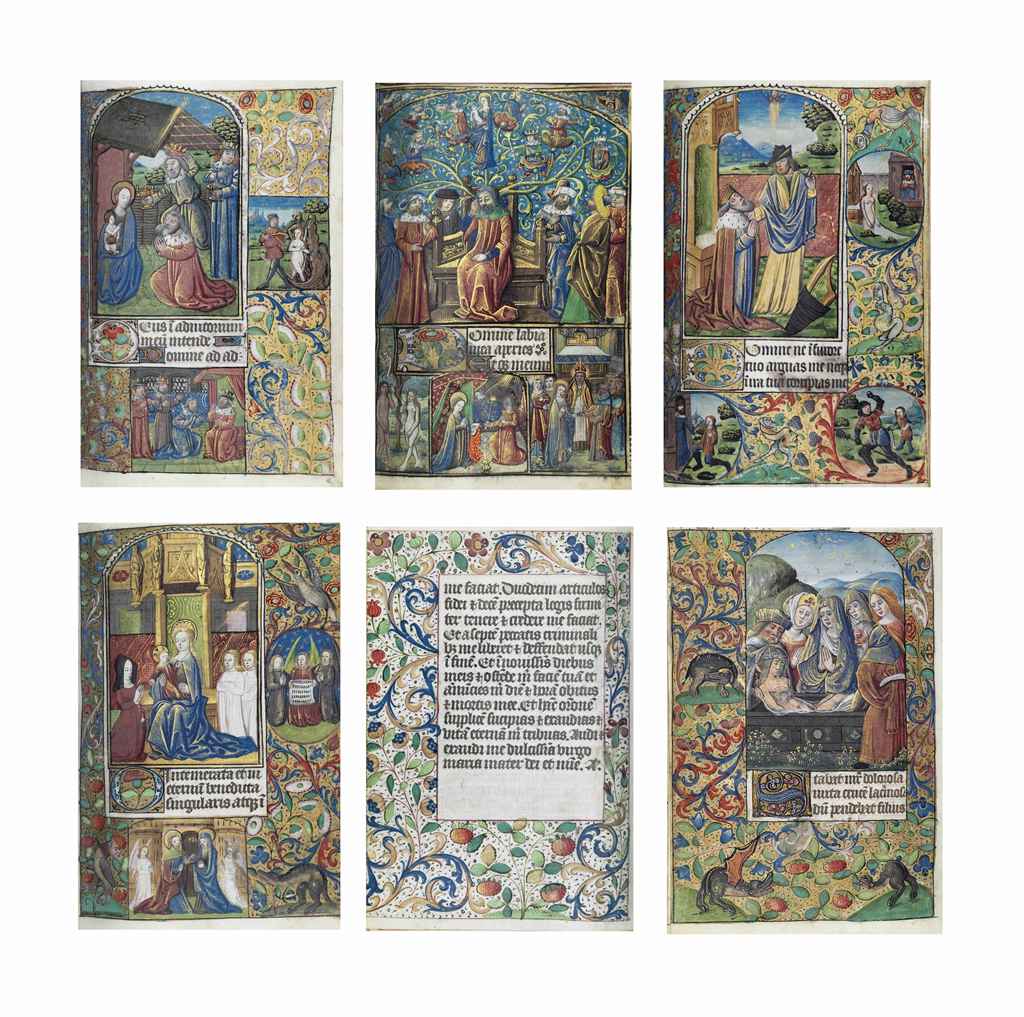
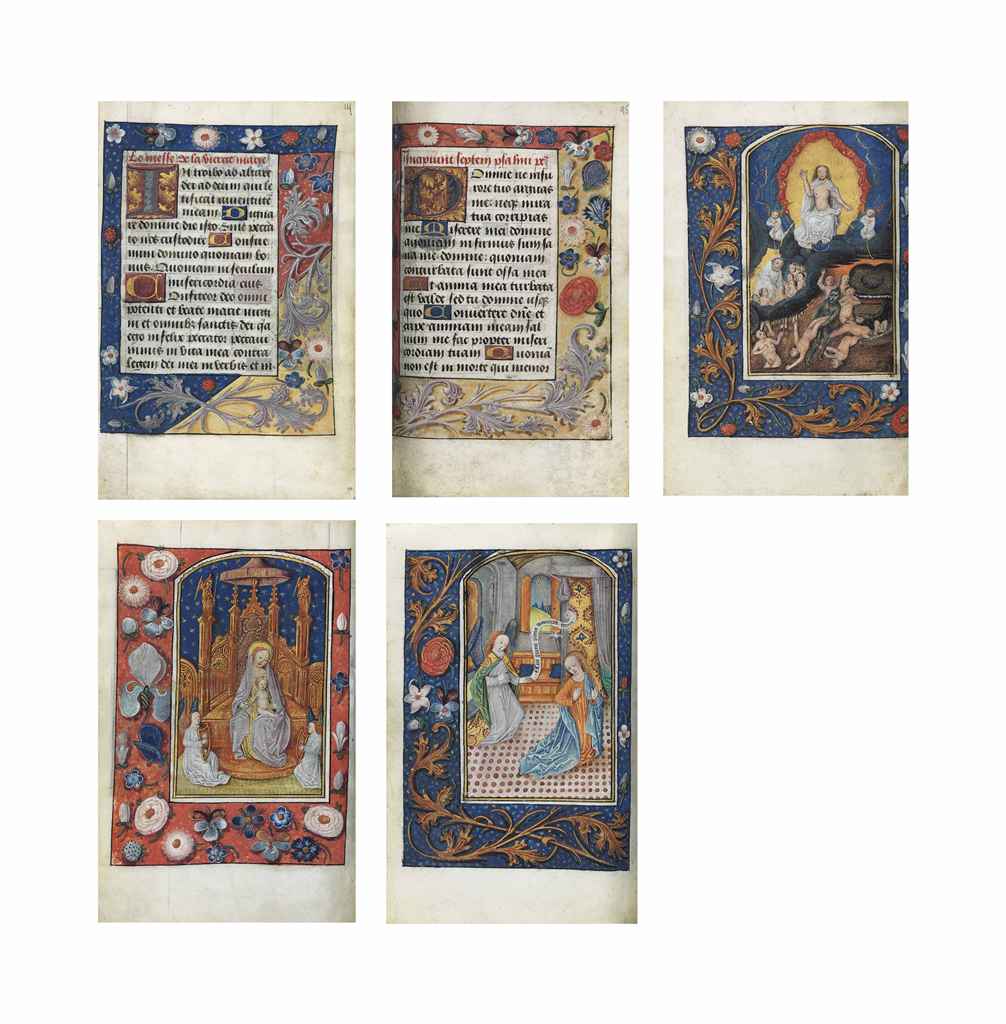
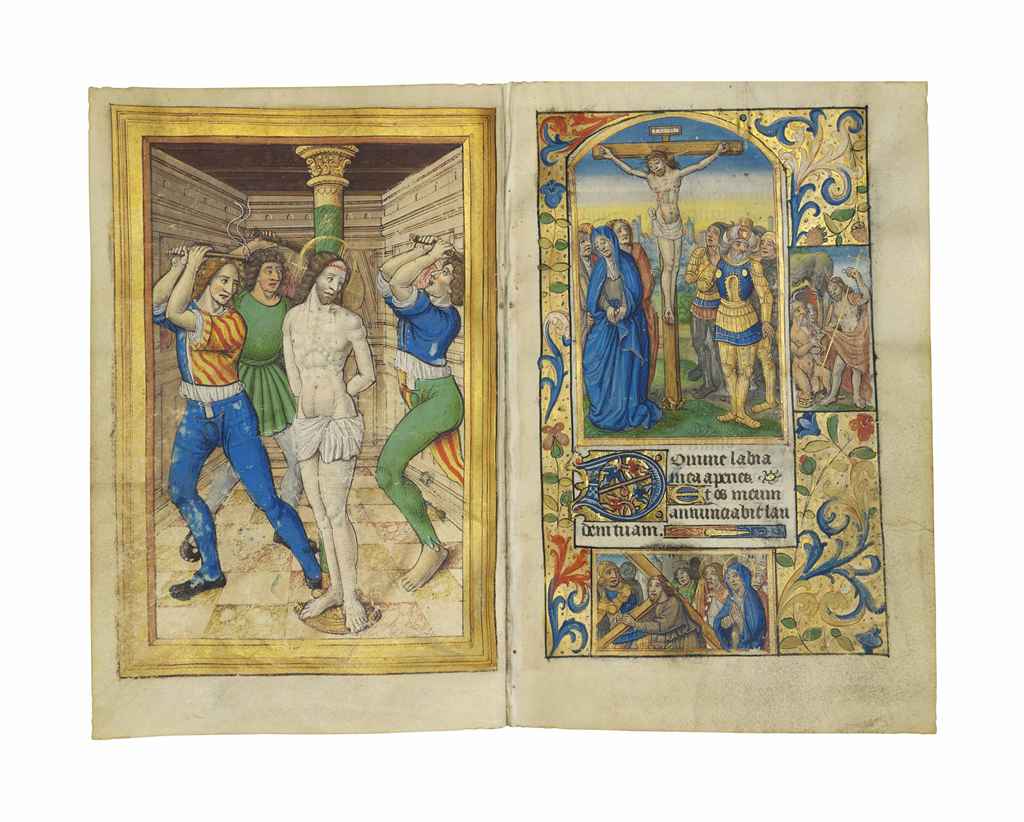
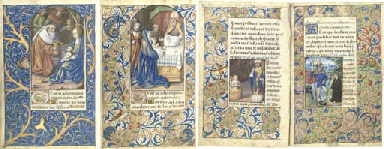
.jpg)
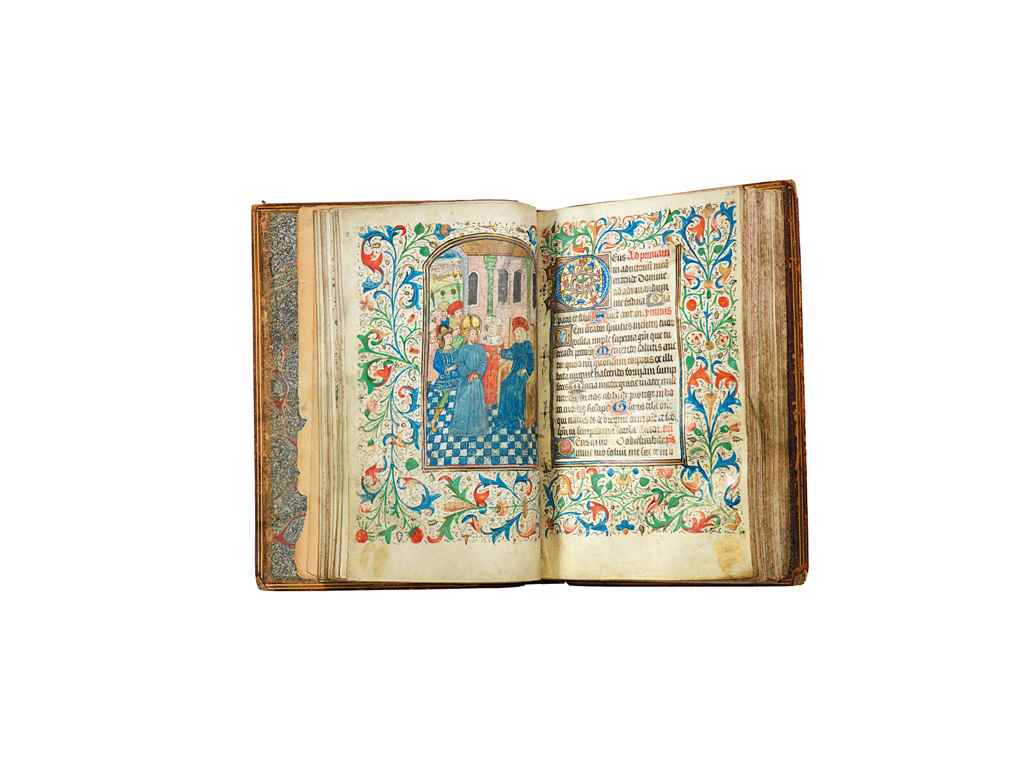


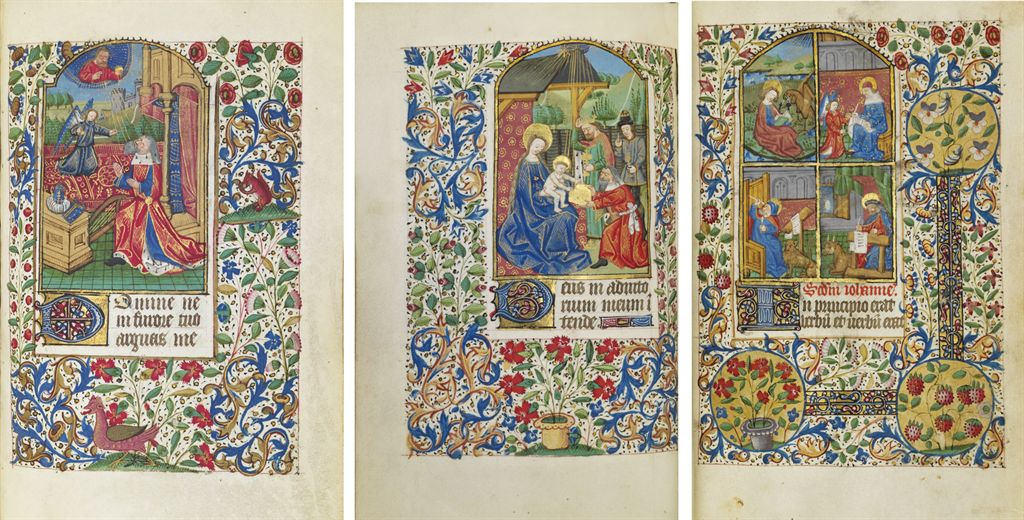
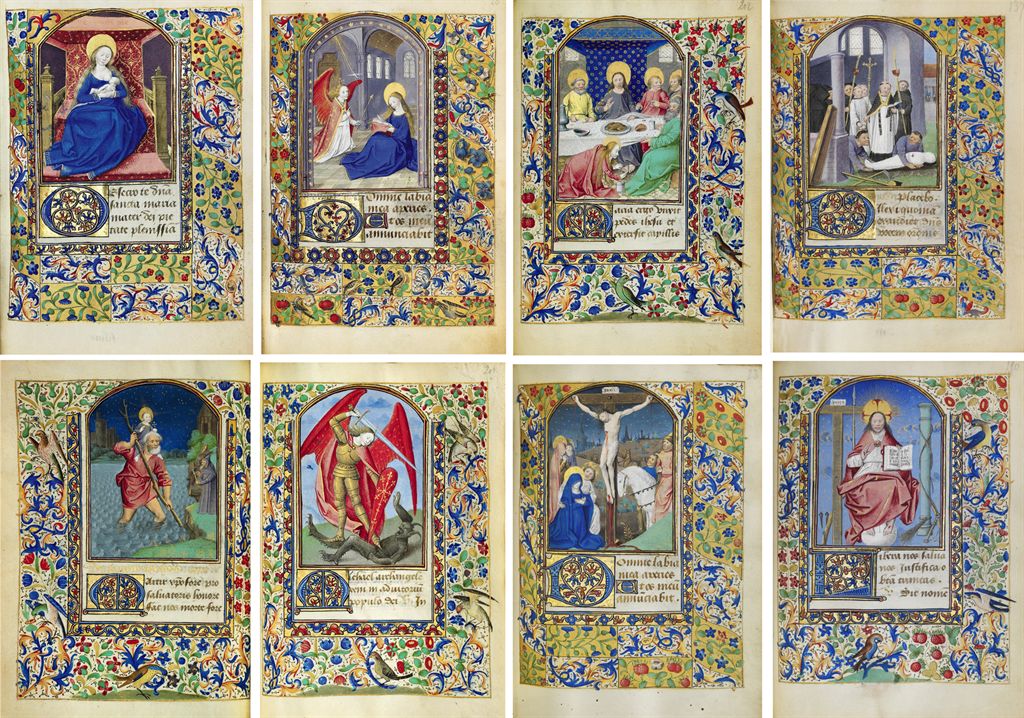
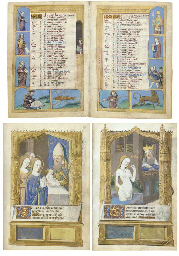
.jpg)


Testen Sie LotSearch und seine Premium-Features 7 Tage - ohne Kosten!
Lassen Sie sich automatisch über neue Objekte in kommenden Auktionen benachrichtigen.
Suchauftrag anlegen